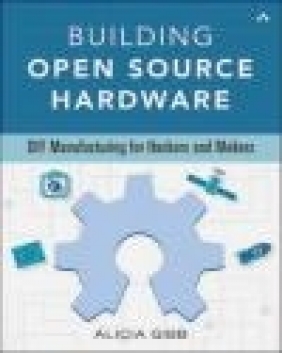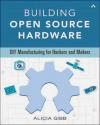Building Open Source Hardware
Alicia Gibb
Building Open Source Hardware
Alicia Gibb
- Producent: Addison Wesley Publishing Company
- Rok produkcji: 2014
- ISBN: 9780321906045
- Ilość stron: 368
- Oprawa: Miękka
Niedostępna
Opis: Building Open Source Hardware - Alicia Gibb
This is the first hands-on guide to the entire process of designing and manufacturing open source hardware. Drawing on extensive personal experience with DIY, maker, and hardware hacking projects, industry-leading contributors share proven approaches to design, remixing, fabrication, manufacturing, troubleshooting, licensing, documentation, and running an open source hardware business. Part I covers the emergence and evolution of open source hardware, what open source hardware licenses mean, and the growing role of standards in making hardware more open. Part II offers contributors' expert advice on key tasks, ranging from creating derivatives to using source files. Part III turns to production, showing how to manufacture at multiple scales-from personal to commercial. Appendixes provide valuable checklists for design, manufacture, security, and documentation. And to foster even more hands-on learning and experimentation, the low-cost Blinky Buildings open source hardware kit is used as an example throughout. Learn how to * Get involved in the open source hardware community-its history and values* Develop designs you can successfully prototype and manufacture* Walk step by step through making derivatives from existing projects* Build open source 3D printers, and remix 3D printable objects* Create open source wearables* Work with diverse source files, from electronics to other physical materials* Fabricate your own designs* Move from prototype to commercial manufacturing, and troubleshoot problems* Choose a business model and build a profitable open source hardware company* Avoid pitfalls associated with trademarks, copyrights, patents, and licensing* Write documentation other hardware hackers can use* Use open source hardware in education, helping students learn without boundariesIntroduction xiii Acknowledgments xxiii About the Authors xxv Part I: Open Source Hardware Theory 1 Chapter 1: History of the Open Hardware Movement 3 The First Programs, Organizations, and Definitions 4 TAPR OHL 6 OHANDA 6 OSHW Definition, Summit, and Logo 7 CERN OHL 8 Forking of Open Hardware and Open Source Hardware 9 Creation of OSHWA 9 References 11 Chapter 2: OSHW Definition and Best Practices 13 Open Source Hardware Definition 13 Best Practices 16 Summary 30 Chapter 3: Licensing Open Source Hardware 31 Licensing 31 Open Licenses in the Context of OSHW 32 Copyright, Patent, and Trademark: Rights That You Might Be Able to License 33 Actually Licensing a Copyright, Patent, or Trademark 36 What to Do Now 39 Summary 40 Resources 41 Chapter 4: Standardization of Open Source Hardware 43 Firming up the Soft Parts: Making Software Firmer 44 Softening up the Hard Parts: Making Hardware More Flexible 47 Other Standardization and Regulation 49 Summary 51 Part II: Hands On! 53 Chapter 5: The Design Process: How to Get from Nothing to Something 55 The Phase of Projects 56 Iterative Design and Concept Refinement 58 Setting up Your Workflow 60 Managing Constant Iteration 61 Every Master Plan Has an Exit Strategy 61 Preparing for Manufacturing 62 Summary 63 Resources 63 Chapter 6: Making a Derivative 65 Derivatives and Open Source Hardware 65 Blinky Buildings Project 69 Summary 81 Chapter 7: Modifying the Shape of an Arduino 83 Shapes of an Arduino Derivative 83 Before You Begin 84 Determining Your Board Outline 87 Lay Out Your Arduino Derivative in Eagle 89 Manufacturing Your Board 91 Summary 93 Resources 94 Chapter 8: Remix a 3D Print(er) 95 Dawn of the Desktop 3D Printer 95 Open Hardware Design for 3D Printing 98 Next Steps 107 Summary 108 Resources 109 Chapter 9: Wearables 111 History of Wearables 111 Conductive Textiles 117 Sewable Microcontrollers and Components 118 EL Wire/Tape/Panel 119 Tools and Techniques 120 Managing Expectations 125 Future of Wearables 126 Summary 127 Resources 127 Chapter 10: Physical Materials 129 Centralized Online Hub for Information Sharing 129 Benefits for the Designers and Customers 130 Flexing the Open Source Hardware Definition to Fit Other Physical Objects and Products That Require Multiple Types of Manufacturing 130 A Range of Products and Industries 134 Summary 150 Part III: Production Bits 151 Chapter 11: Personal Manufacturing in the Digital Age 153 Personal Fabrication, Processes, Parts, and Materials 154 Case Studies 157 Questions for the Future 165 Summary 166 Chapter 12: Accelerate from Making to Manufacturing 167 Manufacturing Partner Decision 168 How SparkFun Electronics Grew to Scale 170 Kitting 174 Design for Manufacturability 174 Equipment Selection and Implementation 177 Supply Chain/Purchasing 182 Resource Planning and Scheduling 184 Testing and Quality Control 185 Future of Open Source, Small-Scale Manufacturing 189 Summary 194 Chapter 13: Troubleshooting from Your Design to Your Manufacturer 197 Manufacturable Designs 198 Selecting Manufacturers 205 The Manufacturing Handoff 206 What Could Really Go Wrong? 209 Quality Control 212 Creative Fixes 213 Summary 216 Chapter 14: Taxonomy of Hardware Documentation 219 README.txt 220 Product Webpage 221 Hardware Source Files 223 Making the Pieces Visible: Bill of Materials 225 Tutorials 226 Creating Community 229 Summary 230 Resources 231 Chapter 15: Business 233 A Natural Business Model 233 The Brand 234 The Open Source Hardware and Open Design Business Model Matrix 235 Summary 251 Chapter 16: Building Open Source Hardware in Academia 253 Life in the Ivory Tower: An Overview 254 Benefits of OSHW for the Academic 255 Increased Visibility, Citations, and Public Relations 263 Increased Funding Opportunities and Student Recruitment 264 Virtuous Cycle 265 OSHW Teaching and Service 268 Summary 275 References 275 Conclusion 279 Changing Incentives 279 Maturity of the Open Source Hardware Movement 280 Looking to the Future 281 Appendix A: Open Source Hardware Checklist 283 OSHW Musts and Mays 284 Appendix B: Open Source Hardware Security Do's and Don'ts 285 Resources 286 Appendix C: Design Process Checklist 289 Concept Refinement 289 Managing Iteration 289 Preparing to Manufacture 290 Appendix D: Design for Manufacture Checklists 291 Finding the Right Contract Manufacturer 291 SparkFun's Core Design for Manufacturability Standards 292 SparkFun's Ancillary Design for Manufacturability Standards 293 Troubleshooting 294 Appendix E: Mach 30's Documentation Ground Rules 297 Appendix F: Blinky Buildings Source Files 301 README 301 About This Kit 301 Materials and Tools 301 Attribution 302 Licensing 302 Source Files 302 Glossary 311 Index 317
Szczegóły: Building Open Source Hardware - Alicia Gibb
Tytuł: Building Open Source Hardware
Autor: Alicia Gibb
Producent: Addison Wesley Publishing Company
ISBN: 9780321906045
Rok produkcji: 2014
Ilość stron: 368
Oprawa: Miękka
Waga: 0.57 kg



















